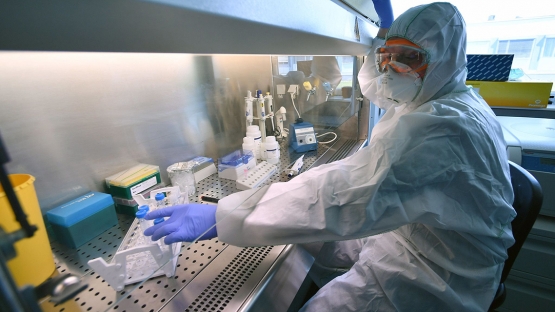Two laboratories where scientists have been trained by the IAEA and the Food and Agriculture Organization of the United Nations (FAO) are now able to use genome sequencing to characterize the virus that causes COVID-19. This technology, with further improvement, could allow them to see where the virus originated and support contact tracing efforts and transmission analysis. The veterinary laboratories in Bosnia Herzegovina and Serbia, countries that have seen a surge in cases in recent weeks, are helping health authorities in their efforts to localize and contain outbreaks.
Bosnia Herzegovina and Serbia Succeed in COVID-19 Virus Characterization with IAEA/FAO Support
Real time RT-PCR is the most accurate method to detect the COVID-19 virus. The FAO/IAEA Animal Protection and Health Laboratory has been helping countries use this technique to detect zoonotic (animal to human) diseases like COVID-19 and Ebola for decades. (Photo: D. Calma/IAEA)
Building on prior technology
The real time reverse transcription–polymerase chain reaction – or RT-PCR as the world has come to know it – is a nuclear derived technology which has been widely used in the detection of the virus that causes COVID-19. With this method, fluorescent dyes are used to detect the presence of specific genetic material and provide scientists with near immediate results on the presence of a virus. Building on this technology, whole genome sequencing is used to find out more about the virus, such as which cluster it belongs to, which enables experts to understand when it was contracted and where. This is done through what is called the phylogenetic tree, which shows the evolutionary relationships of the virus in a patient to known strains.
“With cooperation through a multidisciplinary crisis team working under a one health concept [of animal and human health professionals] we are able to understand exactly from which country we have virus introductions and modify our containment plans from there,” said Goran Cerkez, Assistant Minister at the Federal Ministry of Health in Bosnia and Herzegovina. “Through the genome sequencing we are able to understand more about the virus, how virulent it is and if there are any changes in the virus over time.”
Tanja Jovanovic, virologist and professor at the Medical Faculty of the University of Belgrade, said: “It is very important to have collaboration while assisting public health authorities in order to evaluate effective intervention and how this will change according to changes in the virus. By comparing the sequencing in Serbia with neighbouring countries, we are better able to navigate the virus and predict which containment measures should be in place.”
IAEA support
With support from the IAEA through the network of national veterinary laboratories known as VETLAB, the Veterinary Faculty of the University of Sarajevo and the Veterinary Specialized Institute in Kraljevo, Serbia are now able to perform whole genome sequencing of the COVID-19 virus. The IAEA’s support, delivered through its technical cooperation programme, included training courses, support of fellowships in other laboratories already familiar with the necessary techniques, as well as COVID-19 support materials.
At the Veterinary Faculty in Sarajevo, whole genome sequencing from two COVID-19 outbreak area samples in the country were completed. The phylogenetic tree constructed from this information, combined with other results, led scientists to conclude that there had been multiple lines of virus introductions – suggesting that there are separate infection hubs coming from outside the country.
“At the beginning of the pandemic, veterinary laboratories were a little more prepared than the human health laboratory because we had experience in animal and zoonotic diseases,” said Teufik Goletic, Professor at the Department for Avian Diseases and Management and Head of the Molecular Diagnostics and Research Laboratory at the University of Sarajevo. “By exchanging information and working under a one health approach we can collaborate with decision making bodies and better plan control measures and estimate the impact of COVID-19.”
At the Veterinary Specialist Institute in Kraljevo, more than 13,000 human samples were tested for the COVID-19 virus. RNA was taken and analyzed with whole genome sequencing at the beginning of the COVID-19 pandemic. So far, 17 whole genomes were obtained. The whole genome sequencing of current COVID-19 positive cases is under way to determine if the virus has changed. Through analysis from the first testing, scientists were able to find that there were multiple lines of COVID-19 viruses in Serbia, originating from several countries.
“Genome sequencing alone is not enough, we must learn what these sequences and mutations mean for transmission, pathogenicity and virulence and this can be used for predictions on whether a vaccine will be efficient,” said Dejan Vidanovic, a virologist at the Veterinary Specialized Institute in Kraljevo. “Through sequencing we can see that there are a lot of mutations, but we don’t know if they change the pathogenetic properties of the virus. There are a lot of people working on deciphering these sequences and if we draw the right conclusions, we can more easily fight this.”
The data from whole genome sequencing is uploaded into the National Center for Biotechnology Information database, a bioinformatics website, allowing further research by scientists around the world. When scientists perform whole genome sequencing and upload this information onto the database, connections can be made globally, resulting in more in-depth and accurate phylogenetic trees. This way, the introduction of a virus can be traced to a certain place and strain.




